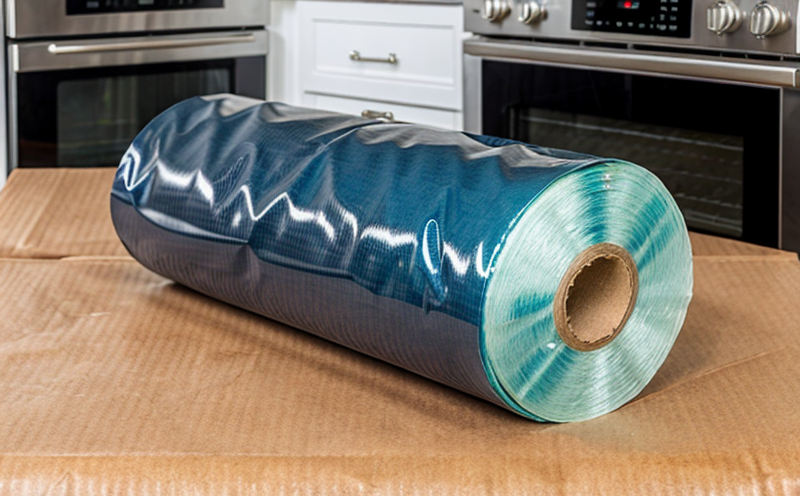UL 94 Flammability Classification Testing of Plastic Wraps
The UL 94 flame retardant plastic classification is one of the most widely recognized standards in the polymer and plastics industry. It specifies the flammability performance requirements for thermoplastic resins, thermosetting materials, and other combustible materials used in the manufacturing of a variety of products including household wraps and covers. Understanding these classifications can be crucial for ensuring that plastic wraps meet stringent safety standards.
The UL 94 flame tests are conducted to determine the flammability classification of plastics according to temperature range, burn time, and other factors. This testing is particularly important in sectors where fire safety is paramount such as household products. For instance, when it comes to plastic wraps used for packaging food or other items, the UL 94 flame retardant test ensures that these materials do not pose a significant fire hazard if exposed to heat.
The UL 94 standard covers several different classifications including V-0, V-1, and V-2. The classification indicates how well a material resists ignition and how rapidly it burns once ignited. For example, a V-0 rating is the highest level of flame resistance, indicating that the material will neither ignite nor continue to burn after being exposed to an open flame.
When considering plastic wraps for household use, the UL 94 flame retardant test is critical because these materials are often in close proximity to food and other combustible items. Any fire hazard could lead to serious safety issues. This testing ensures that the material used meets or exceeds the required standards set by the UL 94 classification system.
The process of conducting a UL 94 flame retardant test involves subjecting specimens of plastic wraps to controlled burning conditions in accordance with strict industry protocols. The specimens are placed into a specific type of holder and subjected to standardized heat sources. Observers then record how the material behaves during and after being exposed to fire.
The results of this testing can be used by quality managers, compliance officers, R&D engineers, and procurement professionals to ensure that their products meet regulatory requirements and industry best practices. This ensures not only safety but also enhances consumer trust in the product's quality and reliability.
- Ensures compliance with UL 94 flame retardant standards
- Provides data on flammability performance under controlled conditions
- Aids in selecting appropriate materials for fire-safe applications
- Supports continuous improvement of product design to meet safety requirements
The importance of this testing cannot be overstated, especially given the increasing demand for safer household products. By understanding and adhering to UL 94 flame retardant standards, manufacturers can ensure that their plastic wraps are not only functional but also safe for use in everyday environments.
Benefits
The benefits of conducting UL 94 flammability classification testing on plastic wraps extend beyond mere compliance with regulatory requirements. This testing provides several key advantages:
- Enhanced Safety: Ensures that the materials used in plastic wraps do not pose a fire hazard, thereby protecting consumers and users from potential safety risks.
- Regulatory Compliance: Helps manufacturers meet stringent industry standards and regulations, which is essential for market access and product acceptance.
- Improved Product Quality: Identifies any weaknesses or deficiencies in the design or manufacturing process of plastic wraps, allowing for continuous quality improvement.
- Informed Decision-Making: Provides critical data that informs decisions related to material selection and product development, leading to more effective and safer products.
- Consumer Trust: Building trust with consumers by demonstrating a commitment to safety and reliability.
- Competitive Advantage: Demonstrating adherence to high standards can set your product apart in the competitive market environment.
In summary, UL 94 flammability classification testing is not just about compliance; it's about ensuring that plastic wraps meet or exceed industry expectations for safety and reliability. By investing in this type of testing, manufacturers can safeguard their products and enhance their reputation in the marketplace.
Why Choose This Test
Quality and Reliability Assurance
The UL 94 flammability classification testing is a cornerstone of quality assurance in the polymer and plastics industry. It ensures that materials used in plastic wraps are safe, reliable, and meet industry standards. This testing process involves rigorous evaluation to determine how well the material resists ignition and burns when exposed to fire.
Manufacturers rely on this test because it provides critical data that can be used to improve product design and manufacturing processes. By identifying any deficiencies early in the development stage, manufacturers can make necessary adjustments to enhance product quality and safety. This not only ensures compliance with regulatory requirements but also helps maintain a high standard of excellence.
The UL 94 classification tests are conducted using standardized methods that ensure consistency and accuracy. These tests typically involve placing specimens into specific holders and subjecting them to controlled burning conditions. Observers then carefully record the behavior of the material during and after exposure to fire, including factors such as burn time, flame spread, and smoke production.
The results of these tests are used by quality managers, compliance officers, R&D engineers, and procurement professionals to make informed decisions about material selection and product development. By adhering to UL 94 standards, manufacturers can ensure that their plastic wraps meet or exceed industry expectations for safety and reliability, thereby enhancing consumer trust.





